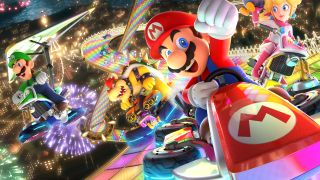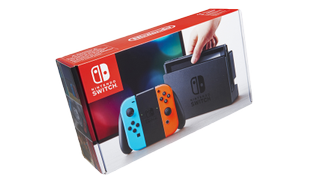Looking to get a Nintendo Switch? Want to show off what it can really do? These are the 7 games you need

Thinking of picking up a Switch soon? You should be. Unless you already have one, in which case, congratulations on a job well done. Launching strong and exploding in ever momentum on a monthly basis, Nintendo’s latest console is an absolute delight, in terms of both software and hardware. Here are the best Nintendo Switch bundle deals right now.
But if you are thinking joining the growing ranks of Switch adopters (‘One of us! One of us!’ I promise we won’t steal your soul), you’ll want to be able to quickly assemble a line-up of games that give you an immediate hit of Just Why The Switch Is Great, in terms of their leverage of the Switch’s many, many cool features. So while some games are obvious must-haves purely on their own merits (Helloooo, The Legend of Zelda: Breath of the Wild), we thought it time to compile a list of the games that, as well as being great, simply do ‘being a Switch game’ really, really well. Here is that list.
- Best deals on a new Nintendo Switch case
- Here are all the Nintendo Switch accessories you need
- Need more space? Here are the best SD cards for Nintendo Switch
Arms

What is it? Nintendo’s second-ever fighting game, after Smash Bros. Arms is a (somewhat) more methodical affair, based on defence, evasion, counter-attacks, and control of long-range space with your ludicrous, stretchy arms.
What does it show off? Really good motion control that can go toe to toe with traditional controller inputs. Let’s face it, given the choice between the two, the analogue-and-buttons option is almost always going to serve you better. And in something as demanding as a fighting game? Waggle shouldn’t get a look in. But five months after its release, the Arms community is still split right down the middle. In fact if anything, motion controls tend to come out on top in most debates, thanks to the additional versatility in movement and multi-directional aiming they afford. However you play it, Arms is a great, surprisingly deep and nuanced fighting game, for all the surface-level lunacy. But resist your natural instinct to eschew the motion control option, and you’ll likely find an even better one.
Voez

What is it? A great, rhythm-action game, and the only Switch game to only work in handheld mode. Seriously, no TV option here. Voez is just that dedicated to what it does, and how it wants to do it.
What does it show off? The Switch’s sharp, multi-touch sensing and, in a wider sense, the sheer, ludicrous versatility of the machine. Think about it. On the one hand you’ve got a console that runs Arms – an extravagant, layered, tactical, kinetic, motion-controlled fist-fight simulator – and on the other, you have a super-polished, delicately designed, decidedly intimate tablet-tapping music game. And both feel like the obvious, de facto way to use the console when playing them. In fact, Voez actually used to be a tablet game, designed bespoke for entirely different hardware. This Switch version might be more expensive, but comes with all of the (many) original DLC packs unlocked from the start. Preserving the original, surprisingly intricate gameplay perfectly, it’s a great showcase for the ‘console that does everything’ promise of the Switch.
Thimbleweed Park

What is it? Monkey Island co-creator Ron Gilbert’s spiritual successor to his early ‘90s Lucasarts adventure games. Part Monkey Island, part Maniac Mansion, part X-Files, it’s both a great throwback to the golden era of the genre, and a brilliant, fresh, modern entry in its own right.
Sign up to the 12DOVE Newsletter
Weekly digests, tales from the communities you love, and more
What does it show off? The scalability of Switch games, and how context can transform the whole experience. Play Thimbleweed Park on the TV, and it works as you’d expect. Analogue sticks and buttons control the point-and-click ‘action’, and everyone on the sofa can join in with puzzle solutions. Undock the Switch, and you’ve got a perfect, laid-back, handheld adventure game, ideal for burning through long train journeys while peacefully ignoring that squealing child and band of drunk, middle-aged blokes on their decades-too-late-for-dignity lads’ day out. Get home a few hours later, start feeling lazy, and you can unplug the Joy-Cons, lie the Switch down in tablet form, and sprawl out on the sofa with it, playing the entire thing in touch-screen mode, absent-mindedly poking and prodding your way to victory, like a sleepy chimp ponderously trying to make contact with zoo visitors through the perspex. One game, totally adaptable to your mood and situation. Or ‘switchuation’, as you might pun, if you had no pride.
Mario Kart 8 Deluxe

What is it? The biggest and best version of one of the biggest and best Mario Karts, retooled for the Switch, and performing better than ever.
What does it show off? A ludicrous array of ever-spiralling local multiplayer options. Remember those early Switch lifestyle ads, where the cool, mid-‘20s folk with the inexplicably huge, cool inner-city apartments had cool barbecues on their cool rooftop terraces, where they inexplicably played cool Mario Kart? ‘Bullshit’, we cried, to every element of the scenario. But a few months later, we became those coolsters, minus the giant apartments and perfectly white teeth, but with the good sense not to touch a game controller with greasy barbecue fingers. Swings and roundabouts. Mario Kart 8 Deluxe, frankly, is silly in how well it uses the Switch hardware for multiplayer. On the TV, you have up to four-player splitscreen with multiple controller options. You also have the facility for online play, with two local racers taking on the world together. Or you can do all of the above on the Switch screen, with the additional players crowded around a desk, for extra-jostley elbow action. Or you can link up to eight Switches for ‘one screen each’ local multiplayer. Or you can link up to 12 via a LAN connector, to create a ludicrous, gigantic, gloriously stupid Mario Kart party. And if you do that, you’re back to allowing up to two players per Switch. Silly. Mario Kart 8 Deluxe’s scope for multiplayer configurations is frankly just really very silly.
Snipperclips

What is it? A puzzle game of delightful invention and wit, soon to be upgraded with a ‘Plus’ version, comprising new worlds and new ways to play. Controlling two small paper people simultaneously, you’ll overlap them to chop various bits off each other in order to reshape them to complete a multitude of ever-evolving challenges. It’s part physics puzzler, part shape sorter, part open-ended, creative experiment.
What does it show off? The Switch’s brilliant scope for fostering ‘viral’ co-op play. Snipperclips is a great puzzler in any context, but it’s the absolute blueprint for encouraging quick, easy, shared gameplay. Getting a friend involved is as simple and welcoming as snapping a lump of chocolate off a sharing bar and passing it over. Just unplug the Joy-Cons, turn them 90 degrees, and away you go. And the effect is transformative. An already clever, immediate puzzle game concept instantly morphs into a giddy, goofy, camaraderie-building carnival of ‘If you just… And if I… No, come over here and I’ll jump on your head…’ Ridiculous possible solutions are spitballed through improvisational chatter, thrown at walls, and then quickly wiped off in favour of even sillier, but potentially more successful, ideas. If you need a game to sell you on the idea of the Switch’s communal play value, you won’t get a better or more uniquely hilarious hit of that than Snipperclips, especially if you both hunker around the Switch in tablet mode.
Tumbleseed

What is it? An ingeniously conceived – albeit brutally hard and unforgiving – action-puzzler in which you must roll a spherical seed left and right along a tiltable vine, to ascend a mountain while avoiding all manner enemies and hazards.
What does it show off? The Switch Joy-Cons’ much vaunted HD rumble. If ever there were evidence for the accuracy of the ‘HD’ part of that name, Tumbleseed is it. Where other pads deliver an abstraction of physical interaction with blunt rattles and thumps, Joy-Cons trick your brain into thinking there’s a real, tangible object moving and reacting inside and around your controller. So, as your tumbling seed tumbles all seed-like from one side of the screen to the other, you’ll miraculously feel it roll from one side of the Switch to the other, from left Joy-Con to right and back again. The HD rumble effect is so nuanced that you’ll even swear you can feel it pass between the two controller halves, in that ‘empty’ space where there is, in fact, no rumble at all. It’s the physical equivalent of binaural audio.
Super Mario Odyssey

What is it? The latest, core-series Mario game, one of the finest 3D ones ever made, and already a front-runner for Game of the Year. Possibly every year.
What does it show off? Immediately, everything that makes Nintendo’s internal developers some of the very finest in the world, in ways that will consistently yet casually blow your mind regardless of your previous experience with the plumber. But beyond that, Super Mario Odyssey is a masterclass in blending gesture-based controls with traditional inputs. Played best with split Joy-Cons, Odyssey plays wonderfully as a ‘standard’ 3D Mario game. But with motion-control thrown in on top, the possibilities are amplified (literally) in every direction. Special jumps get more special with additional modifiers. Cappy abilities become even more potent (and gratifyingly fun), as you throw him out with a tap of Y, and then apply airborne aftertouch with a quick wrist-flick, to extend his flight and hit extra targets. Two handed jiggles bestow on-the-fly, area-of-effect attacks, and speed augmentations to climbing, rolling, and swimming. And the best part? It all feels completely natural, seamless, and organic. You know what? If this is where we are now, maybe the Wii was worth it, after all.
Some online stores give us a small cut if you buy something through one of our links. Read our affiliate policy for more info.
Bloodborne still seems a long way from getting an official 60fps port, but fans have finally gotten PS4 emulators to deliver the remaster they’ve wanted for years
Ultima creator Richard Garriott considered a tabletop version of the pioneering open-world RPG series but isn't sure it would sell: "May be worth finding out"
Most Popular

